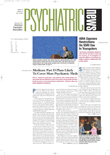In the past decade, the use of mental health treatment in the United States has dramatically increased. Still, many Americans are not receiving minimally adequate care for mental illness.
That's one of numerous findings from the National Comorbidity Survey Replication (NCS-R), published in the June Archives of General Psychiatry in four papers. The NCS-R is a follow-up of the National Comorbidity Survey, whose results provided an overview of Americans' mental health a decade ago.
The lead author of the NCS-R was Ronald Kessler, Ph.D., a professor of health care policy at Harvard Medical School. Other researchers, including psychiatrists, were involved as well.
Although results from the survey are extensive, five major findings stand out:
•
Almost half of all Americans (46 percent) will meet criteria for a DSM-IV disorder sometime in their lifetime.
“The public and policymakers need to realize that the high prevalence is not surprising,” Harold Pincus, M.D., executive vice chair of psychiatry at the University of Pittsburgh and one of the survey authors, told Psychiatric News. “All you have to do is think about the people you know—family, friends, neighbors, coworkers—and how many of them go through some significant emotional turmoil over the course of their lives.”
•
Mental disorders usually have their onset in childhood or adolescence. Such early onset, the researchers wrote, is “opposite the patterns found for almost all chronic physical disorders.... Whatever else we can say about mental disorders, then, they are distinct from chronic physical disorders because they have their strongest foothold in youth.”
•
Although mental disorders are widespread in the U.S. population, the most serious ones are concentrated among a relatively small proportion of cases. Of cases that occur during a 12-month period, about 22 percent can be classified as serious, 37 percent as moderate, and 40 percent as mild. Twelve-month cases were classified as serious if they had any of the following: a suicide attempt with serious lethality intent; work disability or substantial limitation due to a mental or substance disorder; positive screen results for nonaffective psychosis; bipolar I or II disorder; substance dependence with serious role impairment; an impulse-control disorder with repeated serious violence; or any disorder that resulted in 30 or more days out of role in the year.
•
While the vast majority of people with lifetime psychiatric disorders eventually receive treatment, the delay in doing so can be long, on average six to eight years for mood disorders and from nine to 23 years for anxiety disorders.
•
Survey respondents who had a mental disorder that met DSM-IV criteria during the preceding 12 months were asked about any mental health treatment they had received during that time. Only 41 percent reported receiving treatment, and only about one-third of those were classified as having received at least minimally adequate treatment. Minimally adequate treatment was defined as receiving either pharmacotherapy (two months or more of an appropriate medication plus four or more visits to some type of physician) or psychotherapy (eight or more visits with a health care professional lasting on average at least 30 minutes).
Pincus said that he was surprised at “how few people had minimally adequate care— even those seen by psychiatrists, and even those with pretty significant conditions.”
Philip Wang, M.D., Ph.D., told Psychiatric News that he was surprised by this finding as well. Wang is an assistant professor of psychiatry at Harvard Medical School and one of the survey authors.
“[M]ental disorders... are distinct from chronic physical disorders because they have their strongest foothold in youth.”
The irony, Wang said, is “that despite the fairly dramatic increase in the use of mental health treatments that has occurred over the past decade, the adequacy of treatments received by individuals really hasn't improved.”
Nonetheless, while increased use of mental health treatments does not appear to have benefited the public as a whole, undoubtedly individual patients have improved because of them, Kenneth Wells, M.D., believes. Wells is a professor in residence in psychiatry at the University of California at Los Angeles and one of the survey authors.
“The NCS-R study offers some new exploratory data that, along with other research studies, stand to have an impact on the mental health field and need to be further validated in order to understand the greater implications of the findings,” Darrel Regier, M.D., said in an APA press release issued in conjunction with publication of the NCS-R results. “It is important to note that new findings typically need replication and validation.”
Regier is director of the APA Division of Research and the American Psychiatric Institute for Research and Education.
“The findings reported here are the first of what promises to be a bountiful harvest,” Thomas Insel, M.D., and Wayne Fenton, M.D., wrote in an editorial accompanying publication of the results. “The NCS-R is one element in a coordinated program of new psychiatric epidemiological studies that will be completed over the next several years.” Insel is director of the National Institute of Mental Health (NIMH); Fenton is director of the Division of Adult Translational Research and associate director for clinical affairs at NIMH.
The NCS-R was based on interviews of a nationally representative sample of Americans conducted from 2001 to 2003. More than 9,000 subjects aged 18 and older were interviewed using the World Mental Health Survey version of the Composite International Diagnostic Interview, which generates diagnoses of mental disorders in accord with DSM-IV.
The study was funded by the NIMH, National Institute on Drug Abuse, Substance Abuse and Mental Health Services Administration, Robert Wood Johnson Foundation, and John W. Alden Trust.
Arch Gen Psychiatry 2005 62 593
Arch Gen Psychiatry 2005 62 603
Arch Gen Psychiatry 2005 62 617
Arch Gen Psychiatry 2005 62 629
